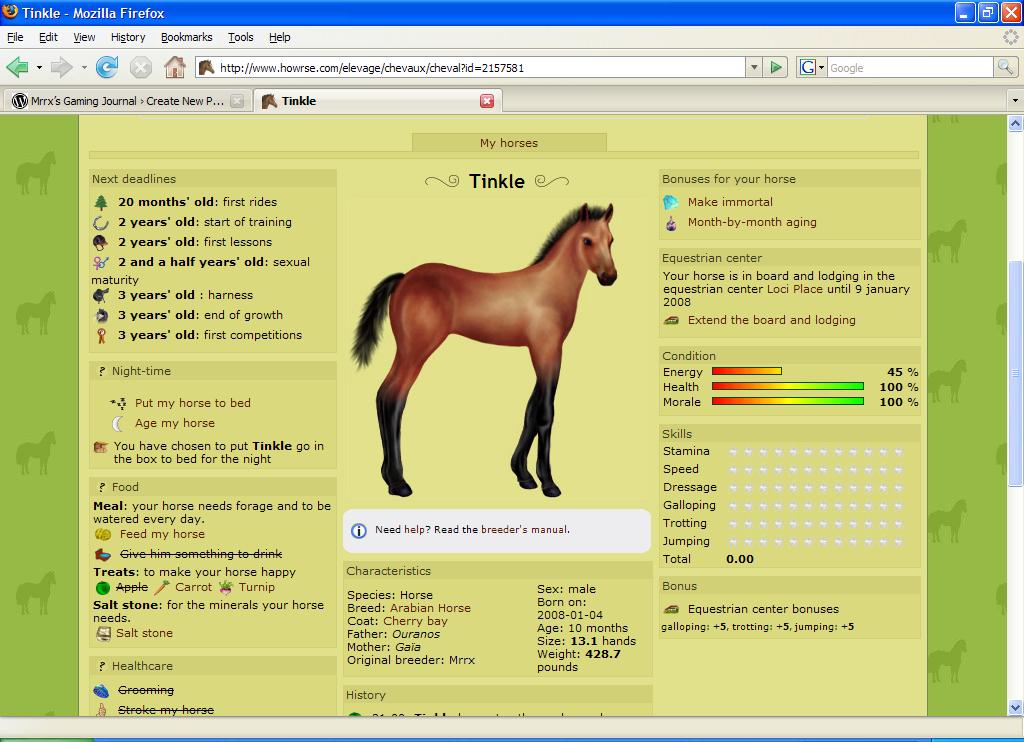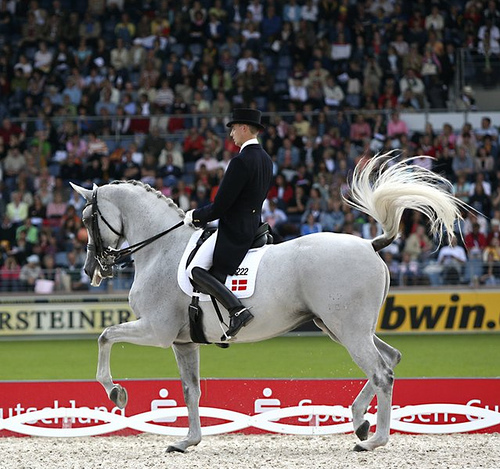Here's a cute little video with the Budweiser Clydesdales.
It's update time:
EXTRA EXTRA!!!! READ ALL ABOUT IT!!!
NEW HORSE IN THE BARN!
Yes she has arrived and is doing exceptionally well. Well, except for the lack of NAME!
"Fluffy" as she has been called her entire life (if you can imagine-poor thing) arrived at London City Stables after a terrifying drive in white-out conditions from Michigan.
Originally owned and trained by Stacy and Jessie Westfall who remember her as a "very sweet mare that we let the kids ride - maybe a 70 or 71 horse" (I will explain this later), Fluffy is bred to rein. Her date of birth is March 6th, 2000, which means she's coming up to her 9th birthday January 1st.
For those of you who read that last paragraph and were WAY confused, allow me to explain breifly. A "70 or 71 horse" refers to what score the Westfalls guess that Fluffy would be capable of for a reining pattern. In a reining pattern, the base score is seventy. The pattern calls for 8 maneuvers, each one beign scored between -2 and +2. This means, that if you perform each maneuver correctly, without any penalties, you would leave the pen with the same score you went in, which would be a 70 (WAY harder than it sounds). Extra points are awarded for horses who perform a maneuver with notable quickness, authority, confidence, etc. The fact that the trainers claimed she is a 70 or 71 horse probably mean she doesn't have any major issues with any one maneuver and could complete a pattern with a score of 70, maybe even plus 1/2 here and there.
The birthday thing: each registered Quarter Horse has a set of papers that give full details about the horse, it's AQHA number, it's registered name, it's birth date etc. Since the show season overlaps with the breeding season, and since many classes are based on the age of the horse, there needed to be a cut-off for the birthdates. The AQHA considers every registered Quarter horse to be born Jan. 1st of the year they were born in, for show purposes. So, Fluffy was born in March of 2008, which means she will be 9 years old on January 1st, 2009. That is one of the advantages of breeding for an early birthdate. Imagine competing on a 2 or 3 yr old horse, who is actually 6 months or more, younger than the competition!
Back to Fluffy.
Registered Name: Smart Like Jac
Sire's Name: Sugar Bars Buckaroo
Dam's Name: Smart N Perfect
Markings: Star, strip and snip extending onto upper lip. no other markings.
Colour: Sorrel
The plan for Fluffy is to (FIND A NEW NAME) work on her feet a bit and see if we can correct some lameness issues she has been having, and to show her through the spring and start the transition into being a lesson horse.
I have decided to have a vote for the name of the horse and let the students decide. Nominations for names have been: Samson, Patriot, Ginger, Tinkerbell, Peanut, Sweet Pea, Snowflake and Honey.
So far, it looks like Sweet Pea is in the lead. If you haven't voted, please tell me your preference ASAP.
 Fluffy looks a little worn out from her long trailer ride from Michigan, the first time in the barn and arena - her new home!
Fluffy looks a little worn out from her long trailer ride from Michigan, the first time in the barn and arena - her new home!New Programs for 2009?
Thanks to everyone who has stuck with me in 2008. It's been a pleasure and I hope to continue growing throughout 2009 to serve you better. It seems like such a long way I have come since I started on my own in the early summer - what a great group of supporters I have!
I would love to come up with some more in depth programs to commit to you. I am looking to find a facility that wil better suit our needs, and until such time I am hesitant to lock anyone into a contract of any sort. As a compromise, I have come up with the bundle prices that are up on the main website under "Coaching". I would encourage everyone to purachase a bundle and book with me your riding times with as much notice as possible. Since it's a "ONE MAN SHOW" for the most part right now, my time is limited. I would really appreciate the extra notice, and the ability to reserve that space just for you. Please note that I will be happy to reschedule any ride, with 24 hours notice. The full amount of the lesson will be forfeited if I have less than 24 hours notice, which will enable me to reschedule rides for other students.
I will be putting together some type of student information form and waiver which will help with my insurance and give me some better ways of keeping track of the best ways to get a hold of everyone, birth days, year-end receipts etc.
Thanks again for your patience and support while I get things running.
Topics for Workshops and Clinics
I will be putting together some Day programs with topics like: mane and tail braiding, tack cleaning, ground work, massage therapy etc. Please let me know if you are interested in any of the above. These programs are a great way to extend your exposure with the horses as well as your knowledge of the animals and the responsibilities of caring for them from day to day.





































 He has 550 money earnng offspring to date which have earned $26,565,935 and reining offspring have earned $484,412. He has sired 17 world champions and 11 reserve world champions.
He has 550 money earnng offspring to date which have earned $26,565,935 and reining offspring have earned $484,412. He has sired 17 world champions and 11 reserve world champions. When I saw him, he had recently had surgery to remove one of his testicles which I believe was cancerous. He was recovering well. Smart Little Lena has been one of the first horses to ever have been cloned.
When I saw him, he had recently had surgery to remove one of his testicles which I believe was cancerous. He was recovering well. Smart Little Lena has been one of the first horses to ever have been cloned. 







